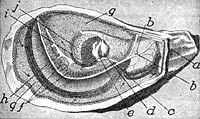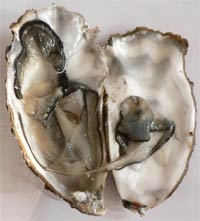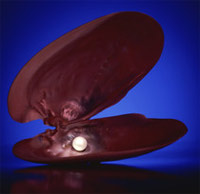|

Pollutant filters: Oysters are filter-feeders that draw water in over their gills through the beating of cilia. Suspended food plankton and particles are trapped in the mucus of the gills and transported to the mouth, where they are eaten, digested and expelled as feces or pseudofeces. Feeding activity is greatest in oysters when water temperatures are above 50°F (10°C). Healthy oysters consume algae and other water-borne  nutrients, each one filtering up to five litres of water per hour. Scientists believe that the Chesapeake Bay's once-flourishing oyster populations historically filtered the estuary's entire water volume of excess nutrients every three or four days. Today that process would take almost a year, and sediment, nutrients, and algae can cause problems in local waters. Oysters filter these pollutants, and either eat them or shape them into small packets that are deposited on the bottom where they are harmless. nutrients, each one filtering up to five litres of water per hour. Scientists believe that the Chesapeake Bay's once-flourishing oyster populations historically filtered the estuary's entire water volume of excess nutrients every three or four days. Today that process would take almost a year, and sediment, nutrients, and algae can cause problems in local waters. Oysters filter these pollutants, and either eat them or shape them into small packets that are deposited on the bottom where they are harmless.
 Colorless blood: Oysters breathe much like fish, using both gills and mantle. The mantle is lined with many small, thin-walled blood vessels which
extract oxygen from the water and expel carbon dioxide. A small,
three-chambered heart, lying under the abductor muscle, pumps colorless
blood, with its supply of oxygen, to all parts of the body. At the
same time a pair of kidneys located on the underside of the muscle
purify the blood of any waste products it has collected. Colorless blood: Oysters breathe much like fish, using both gills and mantle. The mantle is lined with many small, thin-walled blood vessels which
extract oxygen from the water and expel carbon dioxide. A small,
three-chambered heart, lying under the abductor muscle, pumps colorless
blood, with its supply of oxygen, to all parts of the body. At the
same time a pair of kidneys located on the underside of the muscle
purify the blood of any waste products it has collected.
Pearls of foreigners: An oyster produces a pearl when foreign material becomes trapped
inside the shell. The oyster responds to the irritation by producing
nacre, a combination of calcium and protein. The nacre coats the
foreign material and over time produces a pearl.
Dinner plate sized pearls: All types of oysters (and, indeed, many other shelled mollusks) can secrete pearls, but those from edible oysters have no market value. The Pearl Oysters come from a different family, the Pteriidae (Feathered Oysters). Both cultured pearls and natural pearls are obtained from these oysters, though some other mollusks, for example freshwater mussels, also yield pearls of commercial value. The largest pearl-bearing oyster type is the Pinctada maxima, which is roughly the size of a dinner plate. Not all individual oysters produce pearls. In fact, in a haul of three tons of oysters, only around three or four oysters produce perfect pearls.
Grit caused: These oysters produce pearls by covering an invading piece of grit with nacre. Over the years, the grit is covered with enough nacre to form what we know as a pearl. There are many different types and colours and shapes of pearl, but this depends on the pigment of the nacre and the shape of the piece of grit being covered over.
 The perfect pearl: Pearls can also be cultivated by pearl farmers placing a single piece of grit, usually a piece of polished mussel shell, inside the oyster. In three to six years, the oyster will produce a perfect pearl. These pearls are not as valuable as natural pearls, but look exactly the same. In fact since the beginning of the 20th century when several researchers discovered how to produce artificial pearls, the cultured pearl market has far outgrown the natural pearl market. Natural pearls have become scarcer and scarcer and a necklace with only natural pearls can easily costs in the hundreds of thousands of (US) dollars. The perfect pearl: Pearls can also be cultivated by pearl farmers placing a single piece of grit, usually a piece of polished mussel shell, inside the oyster. In three to six years, the oyster will produce a perfect pearl. These pearls are not as valuable as natural pearls, but look exactly the same. In fact since the beginning of the 20th century when several researchers discovered how to produce artificial pearls, the cultured pearl market has far outgrown the natural pearl market. Natural pearls have become scarcer and scarcer and a necklace with only natural pearls can easily costs in the hundreds of thousands of (US) dollars.

There is no way of telling male oysters from females by examining
their shells. While oysters have separate sexes, they may change
sex one or more times during their life span. The gonads, organs
responsible for producing both eggs and sperm, surround the digestive
organs and are made up of sex cells, branching tubules and connective
tissue.
All text is available under the terms
of the GNU Free Documentation License
|